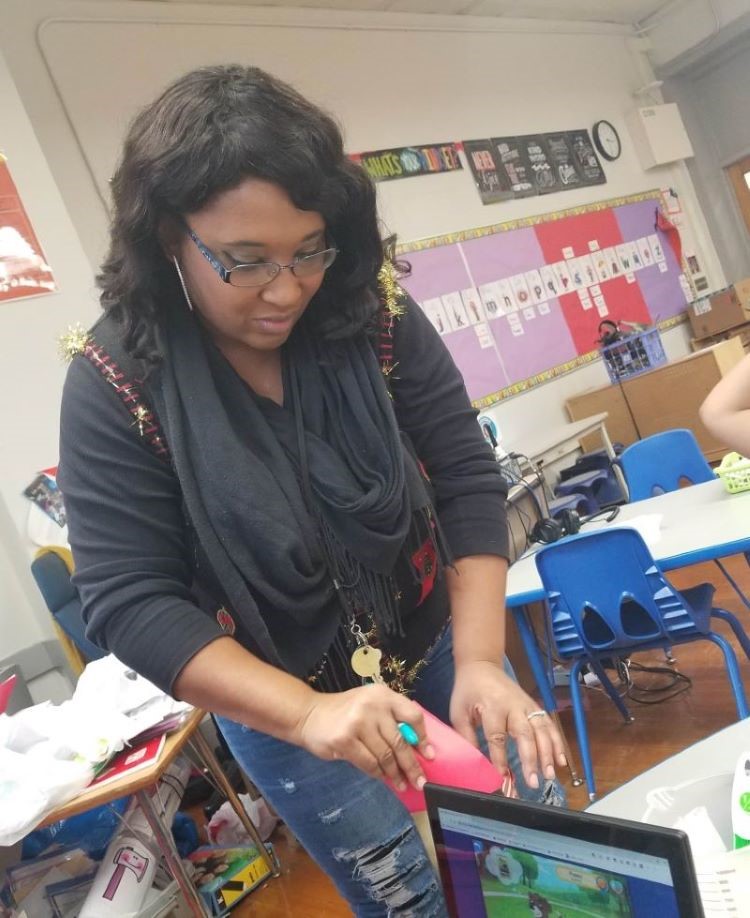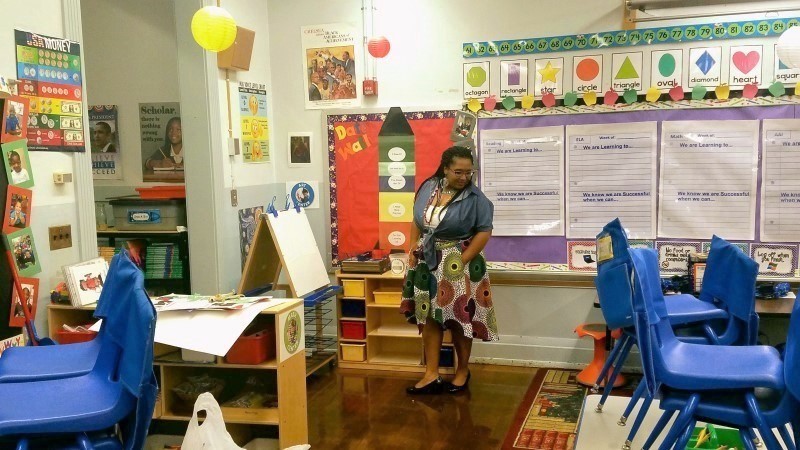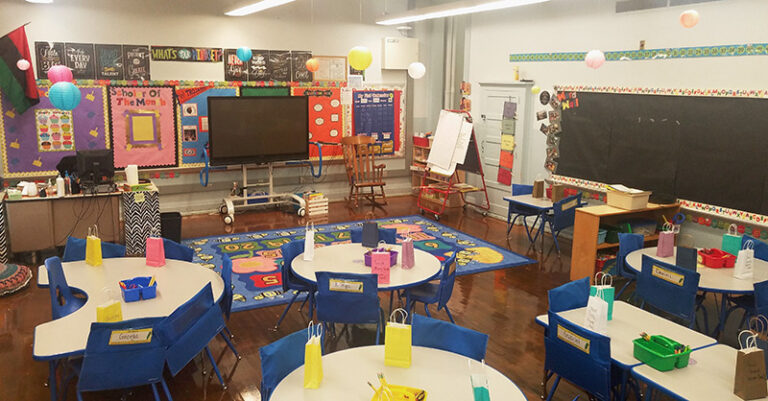Teacher Profile: Angela
Angela Harris
Site: MPS Dr. Martin Luther King Junior Elementary School, Grade 1
Angela Harris started her career in early childhood education (ECE) when she graduated from high school and got her first job at KinderCare. As she took classes around social services, she became interest in child welfare and transitioned into ECE, getting her child development credential and began working on her associates degree in ECE. During work in early childhood community, she worked in daycare, summer camps, the childcare center at Kohl’s Corporate for 10 years, and Head Start for two years. When she finished her bachelor’s degree in ECE, she interviewed with two schools and decided to accept the offer from Dr. Martin Luther King Junior Elementary School (Dr. King).

I knew immediately Dr. King was my home, from the minute that I walked into the building. The principal at that time was trying to revitalize the African American Immersion concept and the whole idea of having a school be the cornerstone of the community and having a school building that immerses students in their culture. I just knew that was the place for me, so I took the job at Dr. King, and I’ve been there ever since. I taught two years in K5 and then I looped with my scholars to the first grade.
[My teaching] is 100% shaped my experience of the educator that I am today; I feel so deeply rooted in my ECE experience. Because early childhood teachers do not get the credit that we deserve ever, and there’s such a separation between my [certification of] school teachers versus the work that happens in the early childhood community. Like my experience with lesson planning, classroom management, and building classroom community, all of that comes from my time at ECE, it was nothing that I learned in my teacher certification program. I remember when I interviewed with my principal, and he spoke, “You’re so different than what I would typically get from a newly graduated teacher candidate, and you are coming with this wealth of knowledge already that a newly certified teacher does not have”. That’s why I’m like such a huge proponent of building this pipeline between ECE and teacher certification. [People] focus heavily on teachers who take the traditional route to certification, but there are just many folks that are going to school for early childhood education.

I always think of a circle when I’m thinking about my classroom. It’s important that they can see me at all times, I can see them at all times, but also, they can see in dialogue with each other at all times. I’ve tried to set up the classroom in a way where theirs backs are never to each other, where everyone can actually see everybody’s faces. I have a combination of circle tables and square tables, but mostly circle tables because circle tables allow me to be able to provide an environment where it’s more of a circular classroom.
I also have the carpet space that is open for them. I have a reflection zone set up in my classroom, if they’re having a hard day or if they just need a moment to themselves, they can go into the reflection zone. I like to keep my classroom bright; I like to keep lots of stuff up on my walls, lots of colors, lots of positive affirmations, lots of things that reflect who they are culturally, and lots of quotes.

I wish I could loop all the time. There’s so much talk around learning loss and gaps, we have very tangible ways that we could prevent that from happening. I have the knowledge of them, and how they learn, and what they need to assist in their learning. If you keep the same teacher for two years, imagine even if that student was below level, the teacher could make up in the next school year because they know that student so well. On the first day of that second year [in my classroom], there was no pause in the learning, and we were able to pick up almost right where we had left off, because we were all used to being with each other and even getting new scholars into that environment. I didn’t even have to do any onboarding, the scholars would tell where your pencils go, where you stuff goes, and where we go wash our hands. They understood all the processes in the routines, and they could explain it.
[My scholars] were very shocked when they got in the first-grade classroom. They were like, “where’s the house area, where’s all the Legos?” They were so used to having play part of their day. And for me, it was also a struggle moving to first grade because I understand how important play is. When you get into the first grade, it becomes very learning-based, and you have to be able to read, very literacy-based, very skills and standards based. Luckily, we’ve had a couple of resolutions that allowed us to have 30 minutes of free play time at the end of the day. And I still have the Legos and all the building blocks and stuff, so during that 30 minute- uninterrupted play time they still can have that experience in the first grade, but it definitely was a wake-up call for them and me, as to shift from allowing them to be children and learn the ways that are beneficial for them to learn versus this is how we know we can produce the results on these tests.
There are definitely ways that I tried to incorporate play [in my classroom]. One example I can think is when we were in math class and talking about tens and ones. We went outside and play this game with pool noodles and tennis balls, and they had to make groups of tens and ones. Some of scholars were pool noodles and some of them were tennis balls. I would tell one group like make 90 and one group make 60. And they would all run around, and I would have to make the groups of tens and ones. Taking a traditional learning experience, but just incorporating in ways that they can have fun and play. It’s not just traditional worksheets or sit down and write this down or copy, or explicitly modeling something for them, but allowing them to learn through play, having these experiences of learning while playing at the same time.
“The best way to teach children is to really meet their needs, so that they can learn the best way that they know how.”
Going back into my ECE days, there was a young boy in my two-year-old classroom, and he was on the autism spectrum. He would not stop screaming no matter what anyone would do, and this would happen a lot during nap time. So, he and I would go out and we would sit in the courtyard. He was such a bright and smart little boy. I always think about him when I interact with my special education students, it makes me reflect on if you give a child what they need when they need it, they will be able to learn. As a teacher in a traditional school space, I have to often say to myself, when I’m teaching, if that’s not working for the students, that’s not their issue, that’s my issue to figure out.
There’s a freedom in the ECE space versus in the traditional school space, because in the early childhood space we’re not tied to report cards or standardized assessment. ECE space is really about providing opportunities to the baby, so that they can grow, learn and develop. We’ve taken that [opportunity] out of the education because we’ve made it so focused upon meeting the standards and assessment benchmarks, and we’ve no longer focused on the true learning, development, and growth of our babies.
I think that the biggest hack is to lean on the veterans in my building, because [if you have an idea], they will be able to tell you if they’ve tried it before, and if it worked or not. Another hack that I’ve learned is to find your people, the folks who you’re going to be able to bounce ideas off, who are going to be able to give you ideas, who are going to be able to talk to you about your practice and how to make it better, and also to listen to you on those days when you feel break down. Early childhood spaces are traditionally smaller than school spaces in terms of the number of employees, it’s so much easier to build familial bond.
All of the deadlines and all of the pressure to meet deadlines and standards, forcing four-, five- and six- year-olds to take standardized tests. They’ve barely built up their social and emotional learning and built relationships with their classmates, and now we’re forcing them to sit for tests that are weeks-long.
As a first-grade teacher, we have report cards, progress reports three times a year; there’s the everyday lesson planning that we have to do, I also have special education students that I have to have individualized plans, and maintaining my portfolios, which allow me to be able to better do my job and keeping communication with families, and all of that has to be documented in the computer. We never think about taking things off teachers’ plates, we always just add more. [We] have to think about how we can put the focus back on what’s important most, that is our students and their development.
I will go back to my time working with Head Start. Being able to provide families with a stable environment, consistent employment, stable housing, access to food and healthcare, allow them to be more involved in their children’s education. I think about creating school spaces that are representative of the community, that have clinics and dentist office, and a space where parents can come and look for employment if they need. I think about caring for the whole child, caring for the whole family and utilizing our funds to lift up our families, so that they can be more supportive in educational spaces. Because when you’re worried about a job or food, going to the parent teacher conferences aren’t going to be a priority.
